Spatial audio revolutionizes your VR multiplayer experience by creating a 3D soundscape where you’ll hear teammates’ voices from their exact positions in the virtual world. You’ll instantly identify enemy movements through precise footstep localization and coordinate strategies 30% more effectively than traditional gaming. The technology uses head-related transfer functions and real-time processing to deliver authentic directional communication, reducing auditory clutter while enhancing situational awareness. Discover how this breakthrough transforms competitive gaming performance.
Understanding Spatial Audio Technology in Virtual Reality
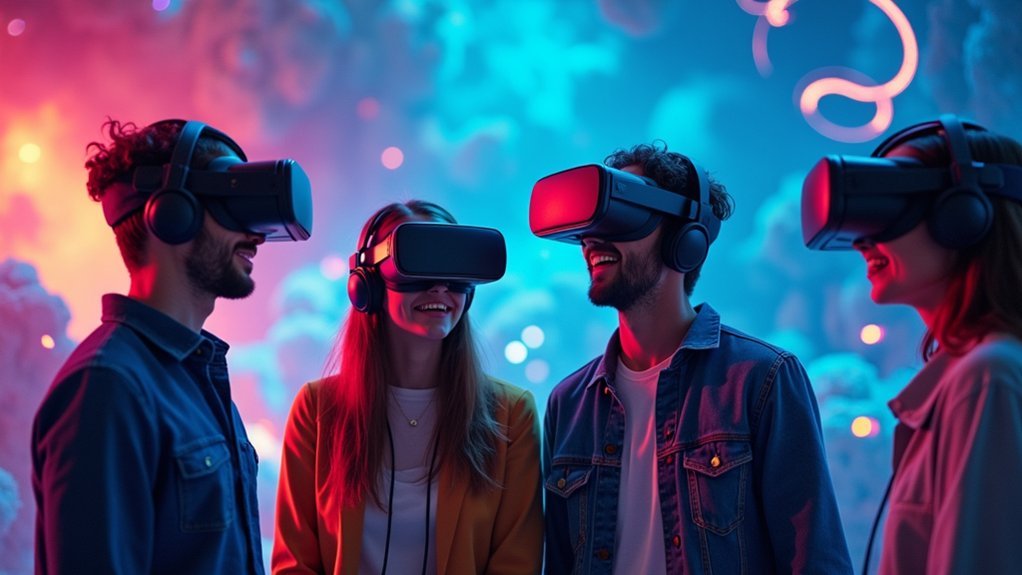
When you put on a VR headset and enter a multiplayer environment, spatial audio technology transforms how you perceive sound by creating a three-dimensional auditory landscape that mirrors real-world hearing.
This immersive experience relies on binaural audio techniques that precisely align sounds with their visual sources, ensuring you hear footsteps approaching from behind or conversations happening to your left with accurate directional clarity.
Head-related transfer functions model how sound interacts with your unique body structure, delivering pinpoint localization that enhances your sense of presence.
Real-time audio processing dynamically adapts to your movements, maintaining consistent spatial relationships as you navigate the virtual reality (VR) environment.
This sophisticated audio foundation greatly improves situational awareness and elevates user interaction quality in multiplayer scenarios.
Enhanced Communication Through Directional Voice Chat
When you’re playing VR multiplayer games with spatial audio, you’ll immediately notice how your teammates’ voices seem to come from their actual positions in the virtual world.
You can instinctively tell whether someone’s calling out from your left, right, or behind you, just like in real life.
This natural sound localization transforms how you coordinate with your team, as you’ll automatically understand not just what they’re saying, but exactly where they’re when they say it.
Natural Sound Localization
As you navigate a virtual battlefield with your team, the ability to pinpoint exactly where your teammate’s urgent warning is coming from can mean the difference between victory and defeat.
Natural sound localization transforms how you perceive and react to vocal communications in VR multiplayer environments. Through spatial audio techniques, you can instantly identify your teammates’ positions based on their voices, dramatically improving your situational awareness during critical moments.
Binaural audio technology guarantees you hear sounds exactly as you’d in reality, with directional voice chat providing precise distance and location cues.
This immersive experience enhances communication efficiency, allowing you to respond faster and coordinate more effectively.
Studies show this technology boosts collaborative task performance by 30%, proving that natural sound localization isn’t just impressive—it’s game-changing.
Realistic Distance Perception
While traditional voice chat systems flatten all communication into a uniform audio stream, spatial audio technology transforms how you perceive distance in VR multiplayer environments.
You’ll naturally distinguish between teammates who are close versus those positioned far away, just as you’d in real life. This realistic distance perception creates truly immersive experiences where communication feels authentic and intuitive.
When players speak, their voices automatically adjust in volume and clarity based on proximity. You can identify which teammates need immediate assistance and communicate more effectively during critical moments.
This enhanced situational awareness strengthens teamwork by allowing you to prioritize conversations with nearby allies while maintaining awareness of distant team members. Spatial audio fundamentally changes how you interact and strategize in virtual spaces.
Immersive Team Coordination
Beyond simply gauging how far teammates are from your position, spatial audio revolutionizes team coordination by transforming voice communication into a directional experience.
You’ll naturally identify who’s speaking based on their location within the virtual reality environment, mimicking real-world interactions.
This immersive technology delivers remarkable benefits for team coordination:
- 30% performance boost – Studies demonstrate significant improvement in team-based tasks when spatial audio enables precise teammate positioning
- Natural communication flow – You’ll communicate instinctively as directional voice chat simulates authentic sound localization
- Reduced auditory clutter – Voice channels assigned to spatial coordinates help you focus on nearby teammates while filtering distant conversations
Your situational awareness improves dramatically as spatial audio eliminates confusion about communication sources, creating more effective teamwork in multiplayer environments.
Immersive Sound Positioning for Player Awareness
You’ll experience unprecedented situational awareness when VR multiplayer games implement 3D audio localization that precisely maps sounds to their spatial origins.
Real-time sound tracking systems continuously update audio positions as you move through the virtual environment, ensuring footsteps, gunfire, and other critical audio cues remain accurately positioned relative to your perspective.
Environmental audio cues become your tactical advantage, allowing you to distinguish between sounds bouncing off walls, echoing through corridors, or emanating from specific elevations around you.
3D Audio Localization
As you navigate a multiplayer VR environment, 3D audio localization transforms how you perceive and react to your surroundings by creating precise spatial sound positioning that mirrors real-world hearing.
This spatial audio technology utilizes head-related transfer functions to generate an authentic 3D audio environment where you’ll experience enhanced player awareness through accurate sound localization.
The integration of binaural audio creates dynamic soundscapes that respond to your every movement:
- You’ll pinpoint enemy footsteps and gunfire direction with remarkable precision
- Your team coordination improves through clear positional audio cues
- Real-world performance increases by 30% when trained with spatial audio systems
Object-based sound design guarantees your multiplayer VR experience remains consistently immersive, allowing you to react faster to threats while maintaining superior situational awareness throughout intense gaming sessions.
Real-Time Sound Tracking
Real-time sound tracking takes 3D audio localization further by continuously updating audio positions as you and other players move throughout the virtual environment.
Advanced algorithms dynamically position audio sources in three-dimensional space, enabling accurate perception of direction and distance relative to your position. Head-related transfer functions (HRTFs) enhance sound localization, helping you determine teammate or enemy locations essential for strategic gameplay in multiplayer experiences.
This immersive sound positioning greatly improves player awareness and situational understanding, leading to better communication and coordination during intense scenarios.
Spatial audio creates deeper presence and engagement, making you feel more connected to virtual surroundings and fellow gamers. Research shows players trained with spatial audio demonstrate 30% improvement in real-world performance, proving its effectiveness for enhancing awareness and reaction times.
Environmental Audio Cues
Environmental audio cues transform how you perceive and navigate virtual multiplayer spaces by providing rich contextual information through carefully designed soundscapes.
Spatial audio technology uses realistic sound localization to position sounds accurately within 3D space, dramatically enhancing your player awareness during critical gaming moments.
These immersive soundscapes deliver precise information through:
- Directional footsteps that reveal enemy positions and movement patterns
- Environmental sounds like wind, machinery, or ambient noise that mask or expose tactical movements
- Distance-based audio fading that helps you gauge proximity to threats or objectives
Accurate auditory cues in multiplayer VR experiences create dynamic environments where every sound matters strategically.
You’ll find yourself naturally developing better spatial reasoning skills as environmental audio cues become integral to your gameplay decision-making process.
Real-Time Audio Processing in Multiplayer Environments
When you’re maneuvering a multiplayer VR environment, every millisecond of audio delay can shatter the illusion of presence and disrupt the seamless flow of interaction with other players. Real-time audio processing guarantees your spatial audio remains synchronized with visual elements, creating an immersive experience that feels natural and responsive.
| Audio Processing Feature | Multiplayer VR Benefit |
|---|---|
| Low Latency Rendering | Maintains presence illusion |
| Spatial Audio Synchronization | Enhances player coordination |
| Accurate Sound Localization | Improves situational awareness |
| Dynamic Acoustic Modeling | Realistic environmental responses |
Advanced audio engines like Wwise deliver high-fidelity sound rendering that adapts instantly to your movements. This technology processes complex acoustic modeling in real-time, including occlusion and reverb effects, guaranteeing maximum user engagement while preserving the authentic feel of shared virtual spaces.
Creating Realistic Virtual Acoustics and Ambience
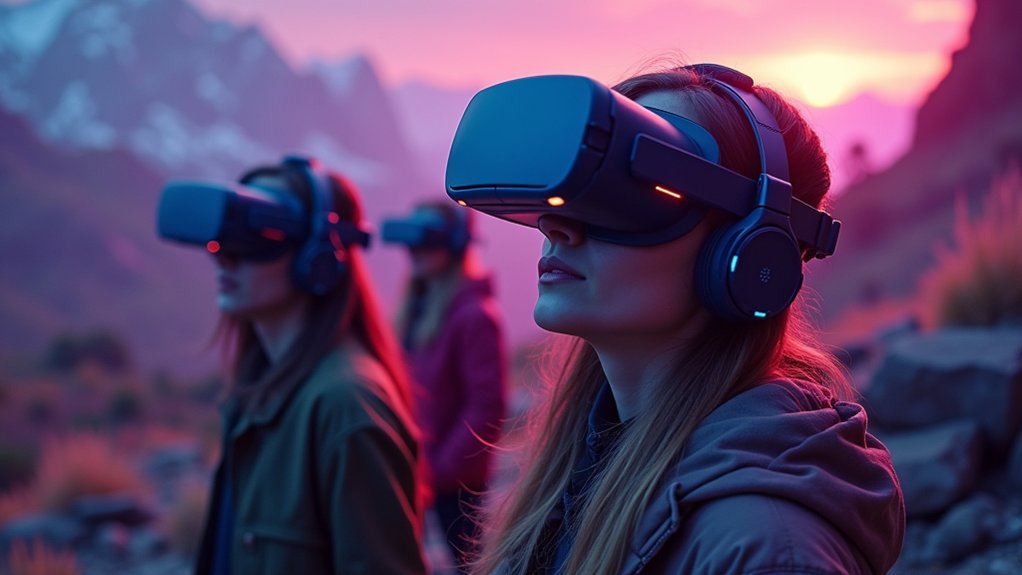
Although visual elements often capture the most attention in VR development, authentic acoustic environments form the invisible foundation that transforms digital spaces into believable worlds.
When you’re designing spatial audio for multiplayer VR, you’re crafting virtual acoustics that create truly immersive experiences through sophisticated environmental acoustics.
Creating realistic soundscapes involves:
- Implementing HRTFs and ambisonics to capture 360-degree audio that responds naturally to your head movements
- Designing dynamic environmental responses where footsteps echo differently in caverns versus open fields
- Integrating directional audio cues that help you locate teammates and threats accurately
These techniques foster an engaging atmosphere where every sound contributes to your sense of presence.
Research shows that proper environmental acoustics can improve your performance by 30% compared to traditional audio, making spatial audio essential for competitive multiplayer VR experiences.
Strategic Gameplay Advantages Through Audio Cues
You’ll gain significant competitive advantages when you master tactical sound positioning in VR multiplayer environments.
Your ability to interpret competitive audio intelligence—like distinguishing enemy footsteps from teammate movements or identifying weapon reload patterns—directly translates to superior strategic decision-making.
These enhanced auditory skills allow you to anticipate opponent actions, coordinate team movements, and execute tactical maneuvers that would be impossible with traditional audio systems.
Tactical Sound Positioning
Because traditional gaming relies heavily on visual cues, you might underestimate how dramatically spatial audio transforms tactical gameplay in VR multiplayer environments.
Tactical sound positioning through spatial audio cues creates immersive soundscapes that give you unprecedented strategic advantages. With precise sound localization in 3D space, you’ll identify opponent locations before they spot you.
Your tactical edge emerges through:
- Directional awareness – You’ll hear footsteps approaching from behind or gunfire from specific angles
- Distance estimation – Close whispers versus distant explosions help gauge proximity and threat levels
- Movement tracking – Real-time audio processing lets you follow enemies through walls and obstacles
In competitive scenarios within multiplayer environments, this technology can improve your performance by up to 30%.
You’re not just hearing sounds—you’re experiencing precise spatial information that transforms how you navigate and strategize.
Competitive Audio Intelligence
Elite VR players have discovered that mastering competitive audio intelligence separates champions from casual gamers in multiplayer arenas.
You’ll develop superior gameplay strategies by leveraging spatial audio to gain tactical advantages over opponents who rely solely on visual cues. Advanced spatial audio techniques like binaural sound processing enable you to track multiple enemy positions simultaneously, creating immersive audio experiences that transform how you approach competitive scenarios.
Your situational awareness dramatically improves when you’re interpreting real-time feedback from dynamic soundscapes.
You’ll anticipate enemy movements, coordinate team strategies, and execute precise flanking maneuvers based on audio intelligence alone. This competitive audio intelligence becomes your strategic edge, allowing you to react faster than opponents and make informed decisions that determine victory in high-stakes multiplayer environments.
Cross-Platform Spatial Audio Implementation Challenges
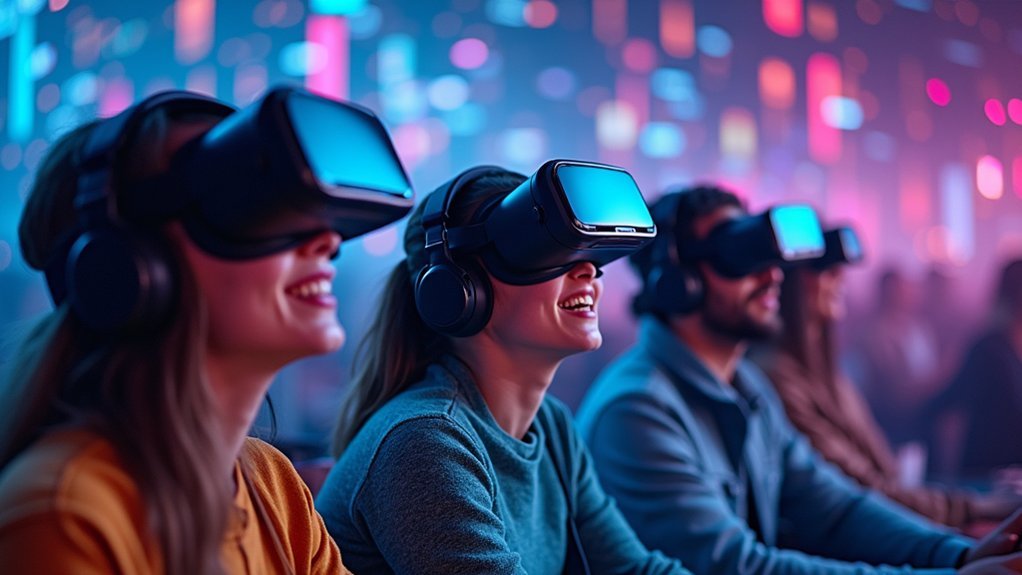
As developers expand VR multiplayer experiences across different platforms, they’re encountering significant hurdles in implementing consistent spatial audio. Your development team faces multiple technical obstacles that can fragment the user experience.
The most pressing cross-platform spatial audio implementation challenges include:
- Hardware variations – Different VR devices process audio differently, creating compatibility issues between proprietary solutions like Dolby Atmos and custom engines.
- Latency management – Audio delays disrupt synchronization between sound and visuals, breaking immersion in multiplayer environments.
- Audio calibration complexity – Individual HRTFs and environmental acoustics require precise adjustments for proper sound localization.
You’ll need standardized protocols to overcome these challenges. Without unified audio standards, your spatial audio implementation will struggle to deliver seamless experiences across platforms, limiting your game’s potential reach and player satisfaction.
Hardware Requirements for Optimal VR Audio Performance
Three core hardware components determine whether your VR spatial audio system delivers professional-grade performance or falls short of player expectations.
First, you’ll need specialized hardware like VR headsets with high-fidelity headphones or built-in speakers tailored for binaural playback. These components guarantee accurate spatial audio experiences by rendering precise sound positioning around your virtual environment.
Second, advanced sound cards and audio interfaces become essential for supporting multi-channel audio output. They enhance your soundscape’s depth and realism while maintaining the processing power needed for real-time audio calculations.
Finally, your system must integrate seamlessly with audio engines like Wwise, FMOD, or Unity. Meeting these hardware requirements creates the foundation for ideal VR audio performance, delivering the immersive experience that transforms multiplayer gaming from ordinary interaction into extraordinary shared adventures.
Social Presence and Emotional Connection in Virtual Spaces
While hardware creates the technical foundation for immersive VR audio, the real magic happens when spatial audio transforms how players connect with each other in virtual spaces.
You’ll experience enhanced social presence as realistic sound cues help you locate teammates and understand their emotions through voice positioning. This creates stronger emotional connection during VR multiplayer sessions.
Spatial audio delivers engaging interactions through:
- Direction awareness – You can pinpoint where teammates are speaking from, making conversations feel natural
- Distance perception – Voices fade appropriately as players move away, mimicking real-world communication
- Environmental context – Background sounds help you share the same immersive experience
These collaborative experiences boost your satisfaction levels considerably compared to traditional stereo audio, making virtual teamwork feel authentic and emotionally rewarding.
Competitive Gaming Applications and Performance Benefits
Beyond fostering social connections, spatial audio becomes your secret weapon in competitive VR gaming scenarios. You’ll experience precise sound localization that lets you pinpoint enemy footsteps and gunfire direction instantly. This creates tactical advantages essential for strategic decision-making in multiplayer settings.
Research shows you’ll perform 30% better in real-world scenarios when trained with spatial audio compared to traditional audio methods. These immersive soundscapes enhance your skill development considerably.
| Gaming Benefit | Performance Impact |
|---|---|
| Sound Localization | 30% better real-world performance |
| Team Communication | Enhanced coordination through audio cues |
| Threat Detection | Faster identification of enemy positions |
Popular titles like “Call of Duty” and “Fortnite” already leverage this technology, proving its effectiveness. The competitive gaming market expects 20.3% growth through 2027, driven by demand for superior audio experiences.
Technical Integration With Popular VR Multiplayer Platforms
When you immerse yourself in VR multiplayer gaming, platforms like Oculus Quest and PlayStation VR seamlessly integrate spatial audio technologies that transform how you perceive and interact within virtual environments.
These immersive soundscapes enhance player communication and situational awareness through sophisticated technical implementations.
Your VR experience benefits from cutting-edge integration features:
- Advanced audio engines like Unity and Wwise enable object-based sound placement, letting you perceive precise directionality and distance
- Head-tracked audio systems adjust sound output based on your head orientation, ensuring teammate voices match their actual positions
- Enhanced gameplay strategy emerges in titles like “Half-Life: Alyx” and “Rec Room,” where you’ll experience 30% improved situational awareness
This technical integration fundamentally changes how you navigate VR multiplayer environments, making spatial audio essential for competitive gaming success.
Future Developments in VR Spatial Audio Technology
As VR spatial audio technology evolves, you’ll witness groundbreaking developments that push the boundaries of immersive multiplayer experiences.
Advanced algorithms powered by machine learning will adapt to your behavior, creating dynamic immersive soundscapes that respond intelligently to multiplayer interactions. You’ll benefit from cloud computing integration, enabling real-time processing that scales across platforms without compromising audio quality.
Enhanced head-related transfer functions will dramatically improve your sound localization accuracy, giving you significant competitive advantages in multiplayer environments.
You’ll experience hybrid AR-VR environments where physical and digital audio blend seamlessly. Market trends support this evolution, with spatial audio projected to grow at 20.3% CAGR through 2027.
These innovations will deliver a realistic auditory experience that transforms how you perceive and interact within VR multiplayer experiences.
Business Impact and Market Opportunities for Developers
These technological advances create substantial revenue opportunities for developers ready to capitalize on the spatial audio revolution.
You’re entering a market projected to grow at 20.3% CAGR through 2027, where immersive experiences define competitive advantage in VR multiplayer gaming.
Your integration of spatial audio technology positions you to:
- Create unique selling propositions that attract customers seeking richer multiplayer experiences
- Develop dynamic soundscapes that boost user engagement and retention rates considerably
- Form strategic partnerships with major gaming platforms adopting these technologies
You’ll enhance players’ situational awareness and performance while building perceived realism that traditional audio can’t match.
As the game industry evolves, your early adoption of spatial audio opens new revenue streams and establishes market leadership in delivering truly immersive VR multiplayer experiences.
Frequently Asked Questions
What Is so Special About Spatial Audio?
Spatial audio creates three-dimensional sound that you’ll perceive as coming from specific directions and distances. You’ll hear sounds moving around you naturally, mimicking real-world hearing for incredibly immersive experiences.
What Is Spatial Audio in VR?
You’ll experience three-dimensional sound simulation in VR that lets you hear audio from different directions and distances. It uses advanced techniques like HRTFs to create realistic soundscapes that match visual elements perfectly.
Why Is VR More Immersive?
You’ll find VR more immersive because it engages multiple senses simultaneously. Spatial audio provides realistic sound cues that match visual elements, creating accurate sound localization that makes you feel truly present in virtual environments.
Does Spatial Audio Good for Gaming?
You’ll gain significant advantages with spatial audio in gaming. It improves your situational awareness by 30%, helps you locate enemies precisely, and enhances strategic decision-making during multiplayer matches for better performance.
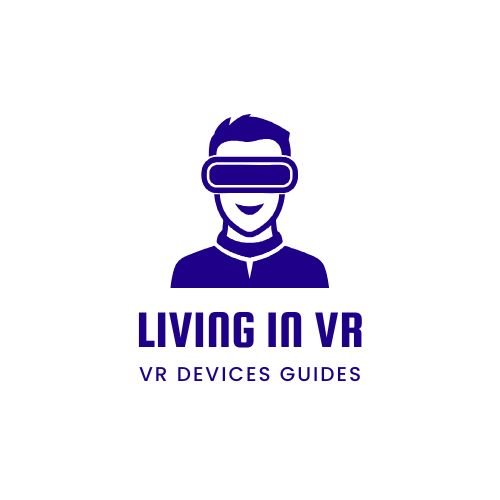
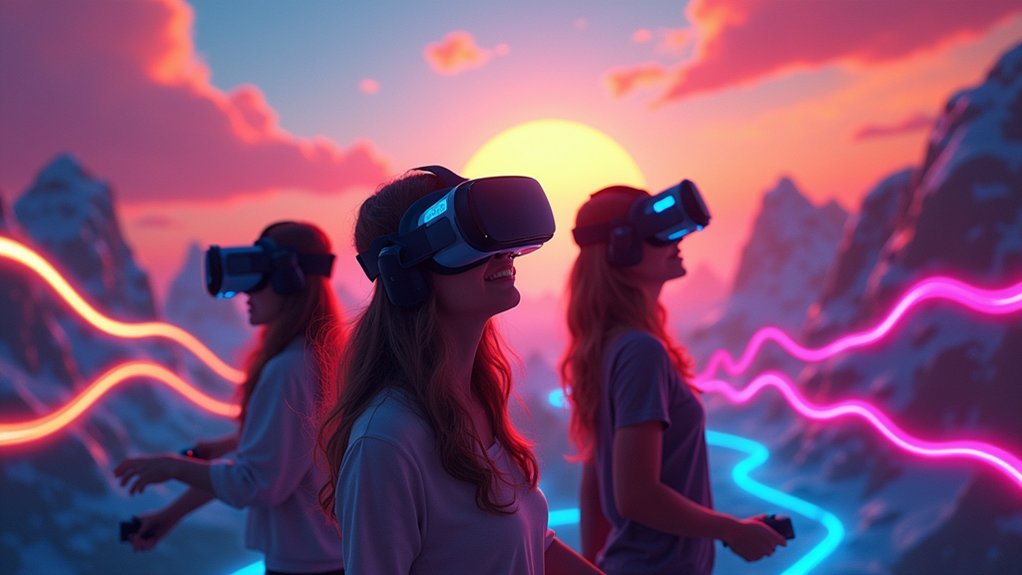
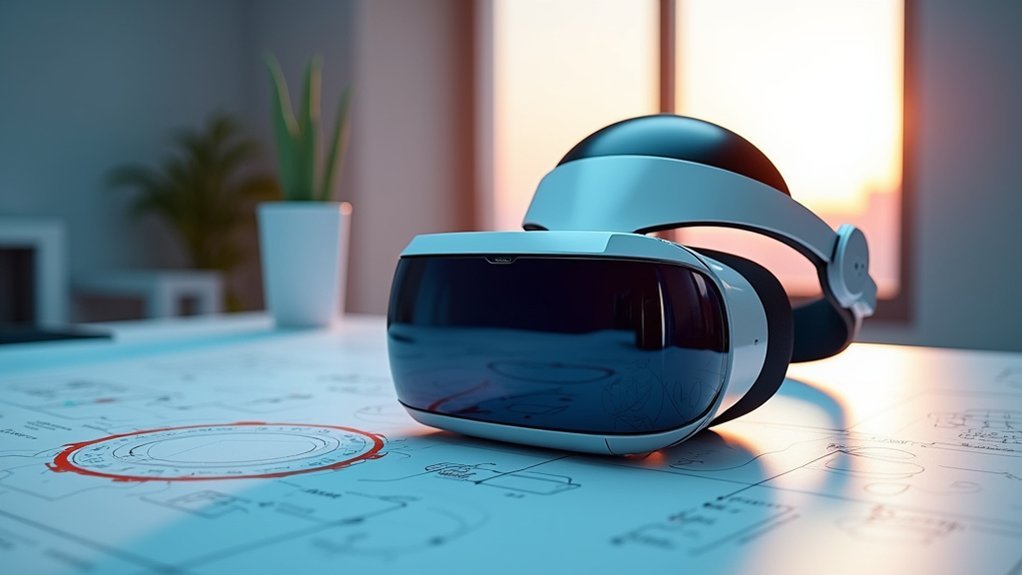

Leave a Reply